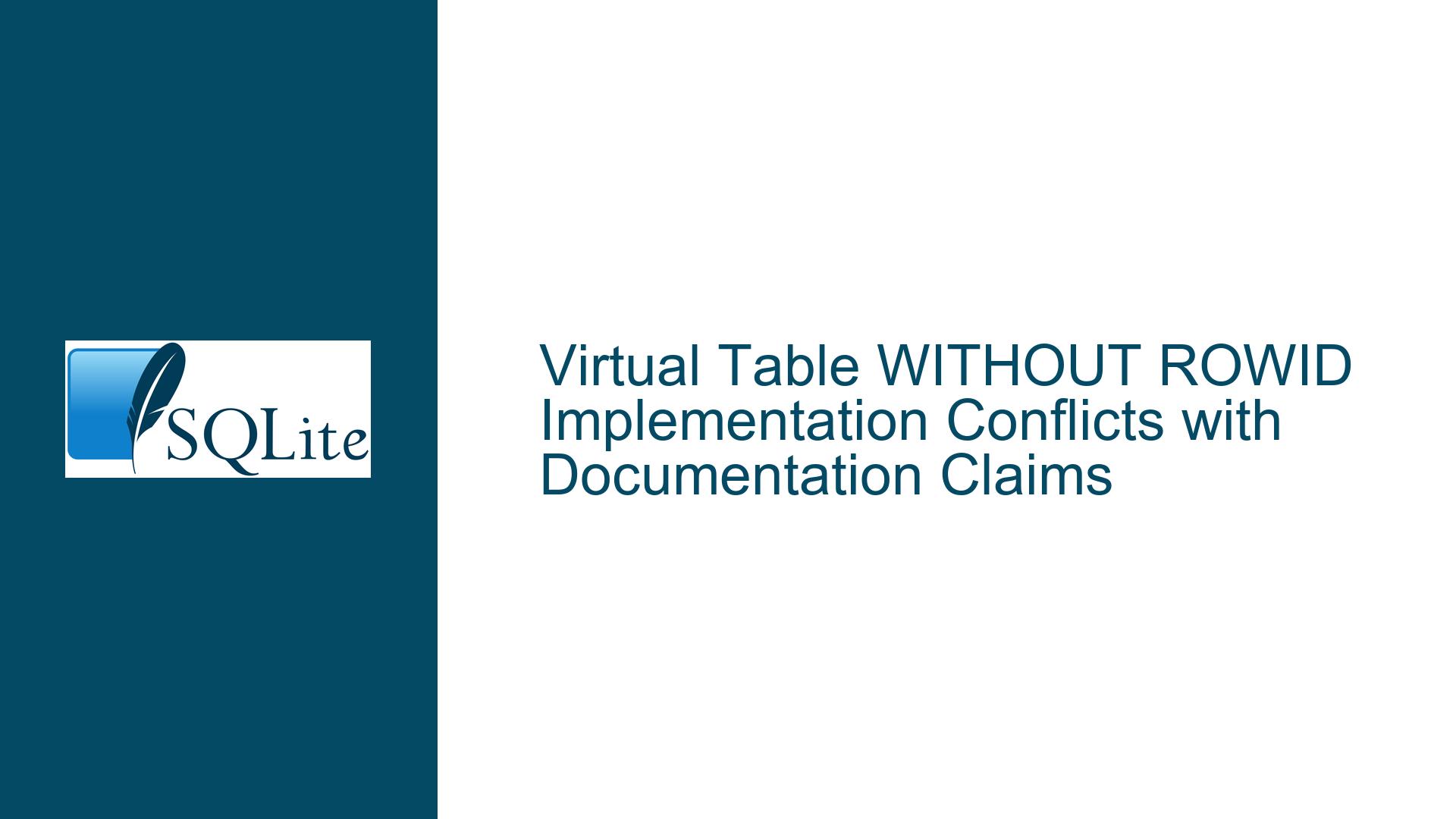Virtual Table WITHOUT ROWID Implementation Conflicts with Documentation Claims
Virtual Table RowID Handling Discrepancy Between Documentation and zipfile Implementation
Virtual Table RowID Requirements vs. WITHOUT ROWID Implementation Patterns
The core issue revolves around an apparent contradiction between SQLite’s virtual table documentation and actual implementation patterns observed in the built-in zipfile extension. SQLite’s official documentation explicitly states that the xRowid method is mandatory for all virtual table implementations. However, examination of the zipfile.c source code reveals a virtual table declaration that omits xRowid while utilizing the WITHOUT ROWID clause in its schema definition. This creates confusion about whether the documentation is outdated, whether the zipfile implementation contains special-case exceptions, or if there’s an undocumented paradigm for virtual table configuration.
At the architectural level, virtual tables require a mechanism to uniquely identify rows. For standard tables (both physical and virtual), this is traditionally handled through the implicit rowid column. The xRowid method in virtual table implementations serves as the bridge between SQLite’s internal row identification system and the virtual table’s data storage mechanism. The documentation’s insistence on xRowid being mandatory stems from this fundamental requirement for row tracking in SQLite’s execution engine.
The conflict emerges when analyzing the zipfile extension’s implementation strategy. By declaring the virtual table with WITHOUT ROWID, the developers have explicitly opted out of the automatic rowid system. Instead, the table definition includes a PRIMARY KEY constraint across multiple columns, which in standard SQLite practice would convert the table to using the primary key columns as the unique identifier. The critical question becomes: How does SQLite reconcile the documented requirement for xRowid with virtual tables that explicitly disable rowid functionality through schema declarations?
This discrepancy has significant implications for virtual table developers. If the documentation remains the authoritative source, then all virtual tables (including those using WITHOUT ROWID) should implement xRowid, which creates logical conflicts when the table schema explicitly avoids rowid usage. Conversely, if the zipfile implementation demonstrates a valid exception pathway, the documentation needs updating to clarify when xRowid becomes optional. This situation creates uncertainty for developers implementing custom virtual tables that would benefit from WITHOUT ROWID optimizations but cannot find authoritative guidance on interface requirements.
Documentation Ambiguity and Virtual Table Implementation Constraints
The primary causes of this discrepancy stem from SQLite’s evolutionary development of virtual table capabilities and documentation update lags. When SQLite 3.14.0 introduced WITHOUT ROWID support for virtual tables in 2016, it created a new paradigm for virtual table implementation that wasn’t fully reconciled with existing documentation about virtual table method requirements. The zipfile extension (added in later versions) demonstrates practical usage of this feature but hasn’t triggered corresponding documentation updates to explain the altered requirements.
A fundamental misunderstanding arises from the difference between physical tables and virtual tables regarding row identification. For physical tables, WITHOUT ROWID simply changes the storage mechanism to use the primary key as the clustering key. For virtual tables, which don’t have physical storage, the WITHOUT ROWID declaration fundamentally changes how the virtual table interface methods interact with SQLite’s core. The xRowid method typically serves as the translation layer between the virtual table’s internal row identifiers and SQLite’s rowid system. When a virtual table declares WITHOUT ROWID, it essentially tells SQLite that the primary key columns will serve as the permanent row identifier, making xRowid unnecessary if the virtual table implementation directly exposes those primary key values through standard column access.
Another critical factor is SQLite’s internal handling of row identification in virtual tables. The xRowid method becomes optional when:
- The virtual table is declared with
WITHOUT ROWID - The virtual table’s
xBestIndexmethod properly handles constraint-based queries - All row access operations can be satisfied through explicit primary key usage
- The virtual table implementation provides stable row identifiers through its primary key columns
The zipfile extension meets these conditions by using the zip archive’s central directory structure as its primary key basis, ensuring that each "row" (file entry) has a unique combination of name and hierarchy position. This allows SQLite to perform row operations through primary key lookups rather than rowid-based access, eliminating the need for xRowid translation. However, the current documentation doesn’t explicitly outline these exception conditions, leading developers to believe xRowid remains mandatory regardless of schema configuration.
Resolving Virtual Table RowID Implementation Conflicts
To address this discrepancy, developers must first verify their SQLite version compatibility. The WITHOUT ROWID clause for virtual tables requires SQLite 3.14.0 or newer. For implementations targeting older versions, the traditional xRowid approach remains mandatory. When using modern SQLite versions, follow these steps to implement WITHOUT ROWID virtual tables correctly while adhering to actual (though undocumented) interface requirements:
Schema Declaration Enforcement
Explicitly includeWITHOUT ROWIDin theCREATE TABLEstatement passed tosqlite3_declare_vtab(). Ensure the virtual table defines a PRIMARY KEY covering all necessary unique identification columns. The primary key columns must be declared as NOT NULL in the schema, though SQLite doesn’t automatically enforce this for virtual tables—the implementation must guarantee non-null values.Virtual Table Method Configuration
Omit thexRowidmethod in thesqlite3_modulestructure by setting it to NULL or zero. This signals to SQLite that row identification will be handled through primary key columns rather than the traditional rowid system. However, ensure thexUpdatemethod (if implemented) properly handles PRIMARY KEY modifications, asWITHOUT ROWIDtables treat primary keys as immutable by default.Indexing and Query Optimization
Implement thexBestIndexmethod to translate SQL query constraints into efficient primary key lookups. Since there’s no rowid, all row access must be driven through the primary key columns or full scans. The virtual table implementation should expose the primary key columns in a way that allows SQLite’s query planner to utilize them for index-based lookups.Row Stability Guarantees
Ensure that the combination of primary key column values remains unique and stable throughout the virtual table’s lifespan. Unlike rowid-based tables where rowids can change,WITHOUT ROWIDvirtual tables require the primary key to permanently identify rows. Any changes to primary key values must be treated as row deletions followed by insertions.Documentation Cross-Referencing
While the core documentation remains ambiguous, consult SQLite’s change logs and source code comments for implementation guidance. The zipfile extension serves as an official example of aWITHOUT ROWIDvirtual table implementation withoutxRowid. Analyze its handling of row identification through thenameandmodecolumns, which collectively serve as the primary key.
For developers encountering crashes or malfunctions when omitting xRowid, conduct the following diagnostic checks:
- Verify that all PRIMARY KEY columns are exposed as HIDDEN or standard columns in the virtual table declaration
- Ensure the virtual table’s
xUpdatemethod (if used) properly validates primary key uniqueness - Confirm that SQLite version 3.14.0 or newer is being used at both compile-time and runtime
- Check that queries against the virtual table utilize the primary key columns in WHERE clauses
- Validate that the
xFiltermethod implementation correctly handles index constraints based on primary key components
In cases where backward compatibility with pre-3.14.0 SQLite versions is required, implement a conditional virtual table structure that uses xRowid when older versions are detected and omits it when WITHOUT ROWID is available. This can be achieved through SQLite’s runtime version checks and dynamic method table configuration.
The ultimate resolution involves recognizing that while the documentation hasn’t been formally updated, the zipfile implementation and SQLite’s core code demonstrate that xRowid becomes optional when a virtual table properly implements WITHOUT ROWID with a valid PRIMARY KEY. Developers should implement their virtual tables accordingly, while being prepared to adjust if future documentation updates clarify the requirements differently.






